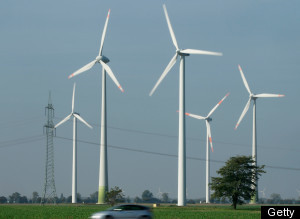 BBC:
BBC: A study has revealed that a wind turbine's colour affects how many insects it attracts, shedding more light on why the turbines occasionally kill bats and birds.
Scientists say that turbines, most commonly painted white or grey, draw in insects. These then lure bats and birds - as they pursue their prey - into the path of the turbine blades.
Support for the idea comes from another study showing that bats are most often killed by turbines at night and in summer, when insects are most abundant.
Paint them purple?
"It had been speculated that insects may be attracted to turbine structures for some reason and this then could attract insectivorous species, such as birds and bats, to forage in the vicinity," said PhD student Chloe Long of Loughborough University, UK.
However, she added, "no other study has looked in detail at what specific insect species might be attracted to turbine installations or why".
So Miss Long and her Loughborough colleagues, Dr James Flint and Dr Paul Lepper, conducted the first empirical study of insect attraction to wind turbines, the results of which are published in the European Journal of Wildlife Research.
In particular, they measured how a turbine's colour alters how many insects gather around it.
Most turbines are painted pure white or light grey, in a bid to make them as visually unobtrusive as possible.
But insects, it seems, are unlikely to ignore these muted tones.
The researchers measured how many insects were attracted to a range of paint colours, including pure white, light and dark grey, sky blue, red and purple.
They did so by laying out coloured cards in a random sequence next to a 13m-high three-blade wind turbine situated in a meadow near Leicestershire, UK.
The scientists were surprised by what they discovered.
"Our major conclusion from this work is that turbine paint colour could be having a significant impact on the attraction of insect species to the structure, both during the day and at night," Miss Long told the BBC.
What is more, turbines painted pure white and light grey drew the most insects bar just one other colour; yellow.
The insects attracted included small flies (body size less than 5mm); large flies (body size equal to or greater than 5mm); greenfly; moths and butterflies; thrips; beetles and crane flies.
"We found it extremely interesting that the common turbine paint colours were so attractive to insects," said Miss Long.
"Our findings support the hypothesis that turbines may be attractive to insects."
The least attractive paint colour to insects was purple.
That does not necessarily mean that all wind turbines should be painted that colour, say the researchers.
But it does imply that changing a turbine's colour could have a profound impact on the number of insects it lures in and therefore the number of birds and bats that follow.
The researchers also found that the ultraviolet and infrared components of paint colour, which humans cannot see but insects can, also had a significant impact, with higher levels of both attracting more insects.
"If the solution were as simple as painting turbine structures in a different colour this could provide a cost-effective mitigation strategy," says Miss Long.
But she and her colleagues suspect that other factors play a role in attracting birds and bats to wind turbines.
As well as the turbines' colour, the heat they generate may attract insects and their predators.
Bats may also find turbines difficult to detect using echolocation.
No comments:
Post a Comment
Note: Only a member of this blog may post a comment.